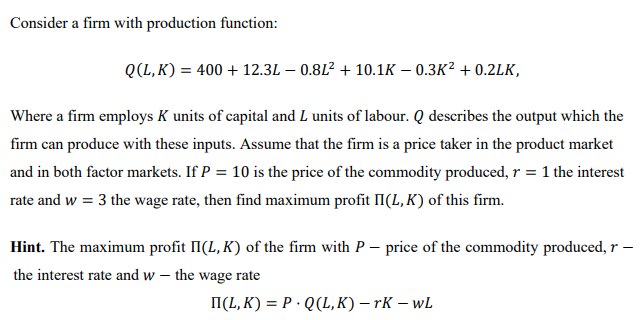Consider a firm with production function: Q(L, K) = 400 + 12.3L – 0.8L² + 10.1K – 0.3K² + 0.2Lk, Where a firm employs K units of capital and L units of labour. Q describes the output which the firm can produce with these inputs. Assume that the firm is a price taker in the product market and in both factor markets. If P = 10 is the price of the commodity produced, r = 1 the interest rate and w = 3 the wage rate, then find maximum profit II(L, K) of this firm. Hint. The maximum profit II(L, K) of the firm with P – price of the commodity produced, r the interest rate and w – the wage rate П(L, К) 3D Р-Q(L, K) — rK — wL
Consider a firm with production function: Q(L, K) = 400 + 12.3L – 0.8L² + 10.1K – 0.3K² + 0.2Lk, Where a firm employs K units of capital and L units of labour. Q describes the output which the firm can produce with these inputs. Assume that the firm is a price taker in the product market and in both factor markets. If P = 10 is the price of the commodity produced, r = 1 the interest rate and w = 3 the wage rate, then find maximum profit II(L, K) of this firm. Hint. The maximum profit II(L, K) of the firm with P – price of the commodity produced, r the interest rate and w – the wage rate П(L, К) 3D Р-Q(L, K) — rK — wL
Managerial Economics: Applications, Strategies and Tactics (MindTap Course List)
14th Edition
ISBN:9781305506381
Author:James R. McGuigan, R. Charles Moyer, Frederick H.deB. Harris
Publisher:James R. McGuigan, R. Charles Moyer, Frederick H.deB. Harris
Chapter7: Production Economics
Section: Chapter Questions
Problem 6E
Related questions
Question
100%

Transcribed Image Text:Consider a firm with production function:
Q(L, K) = 400 + 12.3L – 0.8L? + 10.1K – 0.3K² + 0.2LK,
Where a firm employs K units of capital and L units of labour. Q describes the output which the
firm can produce with these inputs. Assume that the firm is a price taker in the product market
and in both factor markets. If P = 10 is the price of the commodity produced, r = 1 the interest
rate and w = 3 the wage rate, then find maximum profit II(L, K) of this firm.
Hint. The maximum profit II(L, K) of the firm with P – price of the commodity produced, r –
the interest rate and w – the wage rate
I(L, K) = P · Q(L, K) – rK – wL
Expert Solution
This question has been solved!
Explore an expertly crafted, step-by-step solution for a thorough understanding of key concepts.
This is a popular solution!
Trending now
This is a popular solution!
Step by step
Solved in 3 steps with 8 images

Knowledge Booster
Learn more about
Need a deep-dive on the concept behind this application? Look no further. Learn more about this topic, economics and related others by exploring similar questions and additional content below.Recommended textbooks for you

Managerial Economics: Applications, Strategies an…
Economics
ISBN:
9781305506381
Author:
James R. McGuigan, R. Charles Moyer, Frederick H.deB. Harris
Publisher:
Cengage Learning



Managerial Economics: Applications, Strategies an…
Economics
ISBN:
9781305506381
Author:
James R. McGuigan, R. Charles Moyer, Frederick H.deB. Harris
Publisher:
Cengage Learning



Principles of Microeconomics (MindTap Course List)
Economics
ISBN:
9781305971493
Author:
N. Gregory Mankiw
Publisher:
Cengage Learning

